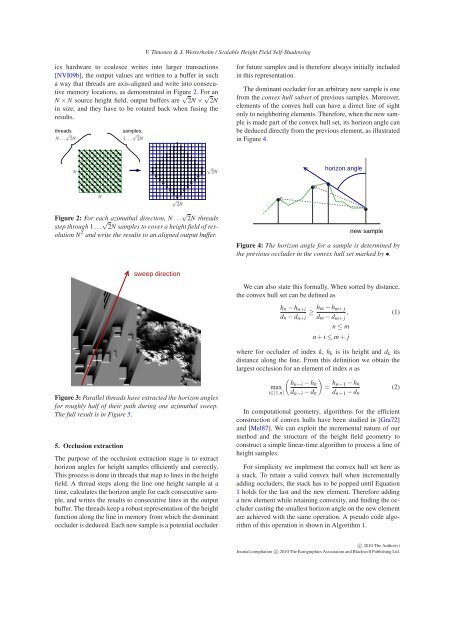Scalable Height Field Self-Shadowing - wili
Scalable Height Field Self-Shadowing - wili
Scalable Height Field Self-Shadowing - wili
You also want an ePaper? Increase the reach of your titles
YUMPU automatically turns print PDFs into web optimized ePapers that Google loves.
ics hardware to coalesce writes into larger transactions<br />
[NVI09b], the output values are written to a buffer in such<br />
a way that threads are axis-aligned and write into consecutive<br />
memory locations, as demonstrated in Figure 2. For an<br />
N ×N source height field, output buffers are √ 2N × √ 2N<br />
in size, and they have to be rotated back when fusing the<br />
results.<br />
Figure 2: For each azimuthal direction, N ... √ 2N threads<br />
stepthrough1... √ 2N samplestocoveraheightfieldofresolutionN<br />
2 andwritethe resultstoan alignedoutput buffer.<br />
Figure3:Parallelthreadshaveextractedthehorizonangles<br />
for roughly half of their path during one azimuthal sweep.<br />
Thefullresultis inFigure5.<br />
5. Occlusion extraction<br />
The purpose of the occlusion extraction stage is to extract<br />
horizon angles for height samples efficiently and correctly.<br />
Thisprocessisdoneinthreadsthatmaptolinesintheheight<br />
field. A thread steps along the line one height sample at a<br />
time,calculatesthehorizonangleforeachconsecutivesample,<br />
and writes the results to consecutive lines in the output<br />
buffer.Thethreadskeeparobustrepresentationoftheheight<br />
functionalongthelineinmemoryfromwhichthedominant<br />
occluderisdeduced.Eachnewsampleisapotentialoccluder<br />
V.Timonen & J. Westerholm /<strong>Scalable</strong> <strong>Height</strong> <strong>Field</strong> <strong>Self</strong>-<strong>Shadowing</strong><br />
for future samples and is therefore always initially included<br />
inthis representation.<br />
Thedominantoccluderforanarbitrarynewsampleisone<br />
from the convex hull subset of previous samples. Moreover,<br />
elements of the convex hull can have a direct line of sight<br />
onlytoneighboringelements.Therefore,whenthenewsample<br />
is made part of the convex hull set, its horizon angle can<br />
bededuceddirectlyfromthepreviouselement,asillustrated<br />
inFigure4.<br />
Figure 4: The horizon angle for a sample is determined by<br />
the previous occluder intheconvex hull setmarked by •.<br />
We can also state this formally. When sorted by distance,<br />
the convex hullsetcan be defined as<br />
hn −hn+i hm −hm+j<br />
≥ , (1)<br />
dn −dn+i dm −dm+j<br />
n ≤m<br />
n+i ≤m+ j<br />
where for occluder of index k, hk is its height and dk its<br />
distance along the line. From this definition we obtain the<br />
largestocclusion for anelement of index nas<br />
max<br />
i∈[1,n]<br />
� hn−i −hn<br />
dn−i −dn<br />
�<br />
= hn−1 −hn<br />
dn−1 −dn<br />
In computational geometry, algorithms for the efficient<br />
construction of convex hulls have been studied in [Gra72]<br />
and [Mel87]. We can exploit the incremental nature of our<br />
method and the structure of the height field geometry to<br />
construct a simple linear-time algorithm to process a line of<br />
height samples.<br />
For simplicity we implement the convex hull set here as<br />
a stack. To retain a valid convex hull when incrementally<br />
adding occluders, the stack has to be popped until Equation<br />
1 holds for the last and the new element. Therefore adding<br />
anewelementwhileretainingconvexity,andfindingtheoccludercastingthesmallesthorizonangleonthenewelement<br />
are achieved with the same operation. A pseudo code algorithmof<br />
this operationis shownin Algorithm 1.<br />
c○ 2010The Author(s)<br />
Journalcompilation c○2010TheEurographicsAssociationandBlackwellPublishingLtd.<br />
(2)



